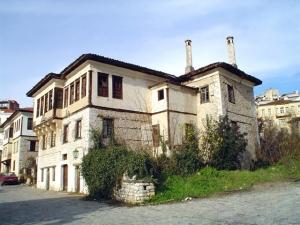Kastoria History
From the 16th Century on, Kastoria has had a public school where many prominent Greek teachers taught. A second school was established in 1713, privately owned by Georgios Kyritzis.
 Kastoria's legends, tradition, history, and reality could mystify and confuse any researcher of Kastoria. For all the pre-named attributes, though, Orestiada Lake, Kastoria’s lake, has been a steady and gracious focus and background.
The name “Kastoria” appears for the first time in the writings of Prokopios, a 6th Century AD historian, referring to the lake and not the city. There are many opinions about the etymology of this name; most probably it derives from the lake which was named after the beavers (Gr. kastores) thriving in it.
Tradition has it that, during pre-Christian years, two cities, Orestida and Keletron or Kilitron, used to exist where Byzantine Kastoria stands today. The name Keletron is derived from the Greek verb kelo = to charm, to attract. The city was built by Aeolis colonists and became the capital of Macedonian Orestes, until it was conquered by Romans in a war against Philippos the E’ (200 BC). The historian, Titus Livius, has made reference to this city by the name of Kilitron.
Emperor Diocletianus had the fortress and the walls of the city reconstructed in 300 AD. The 6th Century AD historian, Prokopios, speaks of its heyday and the destruction of a city named Diocletianoupolis (= the city of Diocletianus), the ruins of which can be seen on the small promontory-like peninsula hugged by the lake. He also mentions that Byzantine Emperor Justinianos, who ordered the building of Constantinople’s Aghia Sofia Church, had the destroyed Diocletianoupols rebuilt and fortified, and later renamed to Justinianoupolis.
Another historian of the period, Skylitzis, informs us of the occupation of the city by Bulgarians in 990 AD. The city was re-occupied in 1018 by the Byzantine Emperor Vassilios II, who, because of his victories against the Bulgarians and his harsh handling of prisoners, was given the nickname Voulgaroktonos (Greek for Killer of Bulgarians). In 1082, Kastoria was conquered by the Normans and, one year later in the fall of 1083, Alexios A’ Komninos re-occupied it. A long period of peace commenced for Kastoria, prerequisite for a noteworthy financial and cultural development. During the 12th and 13th centuries, the development of commerce, thanks to the city’s geographical position, provided the preconditions for a considerable cultural and artistic movement. In 1385, the city was conquered by the Ottomans. It is worth mentioning that the cultural evolution was not at all interrupted; new churches were being built and decorated by prominent artists.
During the 15th Century, Kastoria was one of the largest cities in the Balkans, in terms of population. Its residents were Christians, Turks, and Jews. City Quarters of tailors, jewelers, and furriers were noted in the second half of this century. Tannery and fur production and tailoring obviously engaged, like today, a large number of tradesmen and technicians, and we have proof for this if we go into the large number of commercial contacts with great European centers (Vienna, Venice, Leipzig, Moscow, Budapest), where Kastorians established renowned communities.
From the 16th Century on, Kastoria has had a public school where many prominent Greek teachers taught. A second school was established in 1713, privately owned by Georgios Kyritzis. Some famous 19th Century men of Culture that we should not fail to mention were Ioannis Theologos, doctor at the University of Leipzig; Konstantinos Michail, medical philosopher; Ioannis Michail, writer; and, of course, the poet Athanassios Christopoulos.
During the long period of the Turkish yoke of slavery, Kastoria has been a cradle of Hellenism, not only due to its Schools but also to its battling inhabitants. In 1798, the Kastorian brothers, Ioannis and Panayiotis Emmanouil, were martyred, along with Rigas Ferraeos or Velestinlis. Furthermore, Kastoria took part in the revolution of 1821 and the one in 1878. During the Macedonian war, it took an active part with chieftains, like Paraskevas, captains Kottas, Dalipis, and Dailakis following his leader the Eparch Germanos Karavangelis. Kastoria was eventually freed on November 11, 1912 by the Greek Army, whose leader was the Cavalry Major Ioannis Artis. The contribution of Kastoria in the 1940 epic struggle against the fascist attack was also noteworthy. |
|



